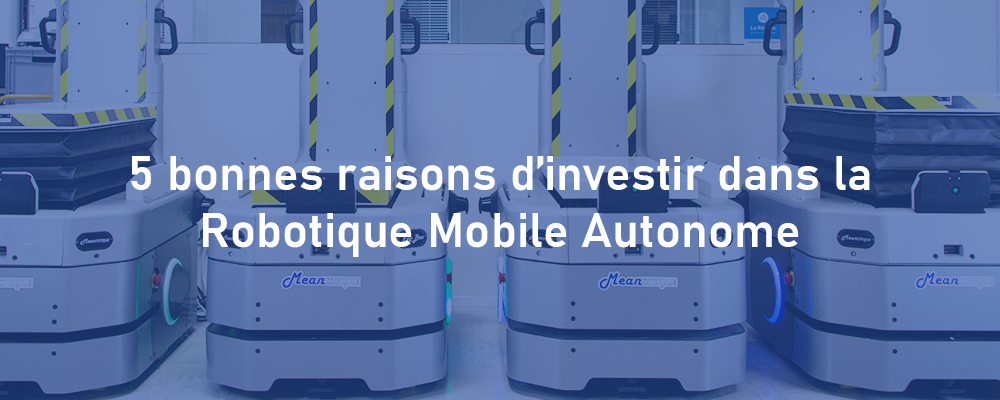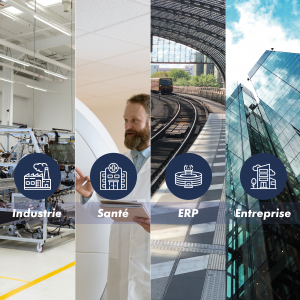
5 good reasons to invest in Autonomous Mobile Robotics
- Expertise
- Temps de lecture : 11 min
Do you want to invest in mobile robots but are not yet convinced? In this article, we give you 5 good reasons to take the plunge and invest in autonomous mobile robotics.
Autonomous Mobile Robots (AMR) enable companies to improve product and service quality, respond effectively to rapidly changing demand, stay competitive, and provide employees with a safer and more secure work environment. stimulating.
Reason n°1: A solution adapted to a large number of sectors of activity

Contrary to popular belief, autonomous mobile robots are not just for warehouses. Indeed, the modularity, the flexibility as well as the high level of intelligence of these robots allow them to evolve in complex environments, in the presence of collaborators and even of general public.
Here are some concrete examples of Meanwhile mobile robot applications:
Manufacturing industry
At a customer’s, 3 mobile robots, Evy-Box, ensure the automatic routing of parts containers within the building. The operator stations are equipped with passive fixed stations for storing empty or full boxes. All of the production scheduling is managed by a stacker crane. The transport orders for full or empty bins are communicated to the fleet manager, the mobile robots are then responsible for transferring the bins (1 or 2 bins) from fixed station to fixed station, according to the defined schedule.
Health facilities
The Nantes University Hospital has decided to centralize the processing of endoscopes. To do this, he opted for the creation of a “flexible endoscope processing center” whose mission is to clean a hundred endoscopes a day. Remote from healthcare services, CETRES has invested in two mobile robots, XuP-Med, available 24/7 to ensure the delivery of endoscopes to the various departments so that they always have the right endoscope, at the right time and in the right place. .
Analysis laboratory:
In a laboratory, the XuP-Med’s mission is to rationalize the flow of samples by automated distribution of tubes to the specialized sectors and the various laboratory teams. When approaching a delivery point, the mobile robot signals its presence by emitting a sound and switching on the luminous glass of the room concerned. After identifying themselves on the interface, the recipient collects their samples and the mobile robot resumes its rounds.
Establishment open to the public:
During trade shows, Meanwhile mobile robots, XuP-Steri A, circulate to disinfect and purify the surrounding air. They draw in polluted air to treat it by reducing fine particles, odors and airborne pollutants like VOCs, bacteria, viruses and mold.
Reason 2: The resilience of AMRs
The many technologies present in autonomous mobile robots allow them to cope with the vagaries of their environment, without interrupting their activity. Indeed, AMRs adapt very easily to agile production systems on sites of all sizes. If production cells are moved or new cells or processes are added, a new building plan can be easily and quickly transferred.
His “Self-healing” system allows him to compensate for his own shortcomings. Unlike a traditional industrial machine which, if it breaks down, blocks the production line. In other words, if one of my mobile robots breaks down, my deliveries will not be penalized. Therefore, it is the other mobile robots that will come to replace it.
Thanks to this resilience, companies avoid costly changes to their infrastructure as well as downtime when they have to rearrange the site. Companies are able to adapt to the changes imposed by the current situation by reorganizing their operational processes at lower costs, while optimizing their efficiency and competitiveness.
Reason 3: A 100% autonomous system available 24/7
Autonomous mobile robots are equipped with artificial intelligence specialized in indoor navigation. Its complex algorithms allow the robot to build its environment and modify its behavior based on unmapped obstacles while locating itself in real time. In order to move autonomously and without a predefined trajectory, the robot will combine its own information with information from its environment (returned by its lasers and sensors). In the event of obstacles (operators, pallets, forklifts, etc.) obstructing its passage, the mobile robot circumvents it in complete safety, determining an alternative trajectory. The most advanced AMRs, capable of opening doors and taking the elevator, can be integrated into any type of indoor environment.
Furthermore, thanks to their reloading strategy, mobile robots can maintain a constant load rate of the robot fleet. This process can be used when the application requires the robot fleet to operate 24/7. This setting consists of specifying a sufficient number of robots in the fleet so that a percentage of this fleet is always in charge and able to easily replace a robot that is nearing the end of its discharge cycle.
Productivity is optimized because supply deadlines are more easily met.
Reason 4: A turnkey solution
Autonomous mobile robots: Yes, but not only….

Thanks to the peri-robotic ecosystem developed by Meanwhile, our customers are able to use complex ultra-connected processes in a very intuitive way, thus facilitating their task and increasing their productivity. This ecosystem facilitates the implementation of AMRs at a lower cost and without modifying the existing infrastructure.
It is important to specify that the installation of AMR is possible even in old buildings and without making the existing equipment obsolete.
How is it possible ?
Thanks to Mw² (Middleware from Meanwhile), which is a management application, similar to an MCS and hosted by the customer (support to be defined during the study phase, for example the customer’s virtual machine). It is developed by Meanwhile, specifically for the needs of the project. Mw² makes it possible to make the link between the world of robotics (with its specific language), peri-robotics (such as fixed stations or an elevator for example) and the customer’s existing equipment / software. The Mw² application also makes it possible to retrieve the status of all project equipment, including mobile robots. It thus processes the faults and alarms reported. In addition, the management application provides access to a large number of parameters necessary for the project. In particular those for the management of priorities, thus making it possible to modify the prioritization strategies for example.
Meanwhile aims to facilitate access to autonomous mobile robotics by allowing the customer to customize their solution through options, Human-Machine/Machine-Machine interfaces such as Omnireport (reporting software), the Omnibox, elevator manager etc. In addition to hardware and software products, Meanwhile also offers a range of services ranging from installation to team training, as well as assistance and maintenance of on-site solutions.
Reason n°5: Improving the working conditions of your employees
“Innovation only has place on the condition that it is at the service of being”
In France, Musculoskeletal Disorders are the leading cause of occupational disease (Source: INRS ED 6087). Logistical operations being by nature repetitive and soliciting the musculoskeletal apparatus of man, generate associated disorders.
The primary objective of autonomous mobile robots is to relieve personnel in the execution of their missions. Thanks to them, musculoskeletal disorders are significantly reduced. AMR relieves employees of low value-added tasks such as transporting loads and energy-intensive travel. They can then focus on their core business.
In addition, their ergonomic design makes it easy and intuitive to interact with the mobile robot. (For example: Knowing the state of the robot, interacting with the robot, modifying the mission(s) in progress, the configuration of the communication channels, handling the mobile robot in maintenance mode, etc.)
Indeed, the solutions offered by Meanwhile are C.E. certified. They comply with the ISO 3691-4 standard, the Machinery Directive 2006/42/EC and are also equipped with laser scanners. Meanwhile undertakes to carry out a complete risk analysis of each solution provided, taking into account the environment in which mobile robots operate. We provide this risk analysis as a deliverable of the application, thus ensuring complete transparency on safety and environmental aspects.
Autonomous mobile robots open up great prospects for companies to meet current and future logistics challenges. AMRs offer, from an operational and social point of view, effective responses to the challenges of productivity, flexibility, safety and performance in order to allow companies to remain competitive while optimizing job satisfaction. In recent years, new leasing models have provided companies with greater flexibility in financial planning for automation.